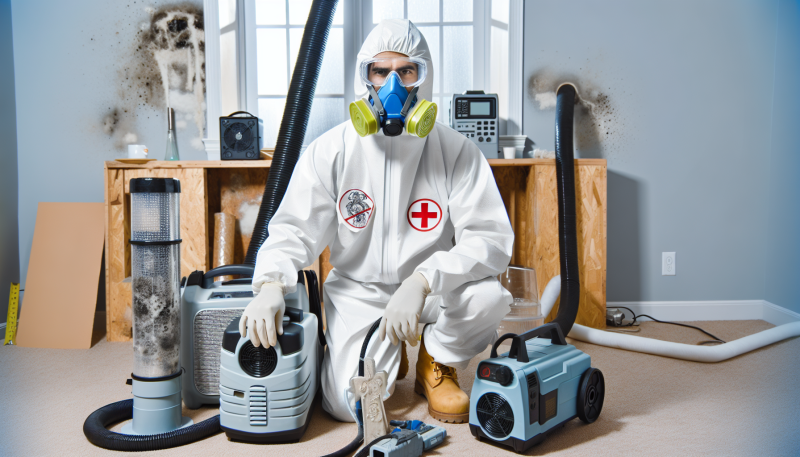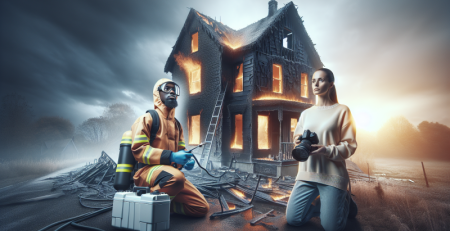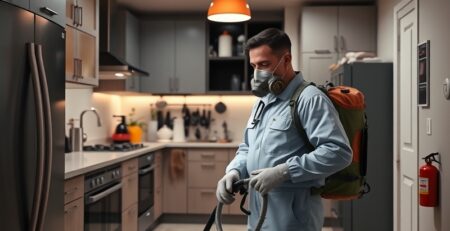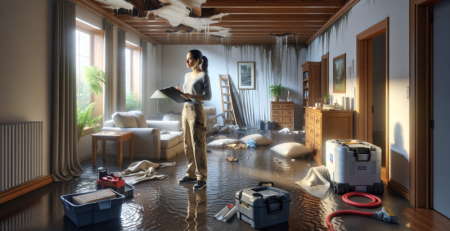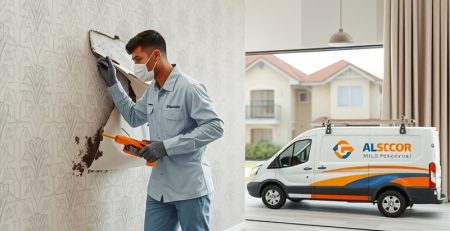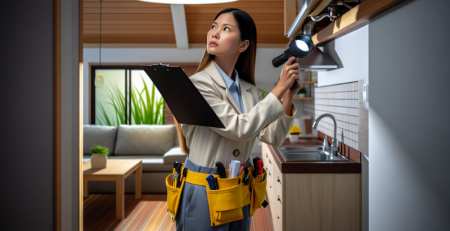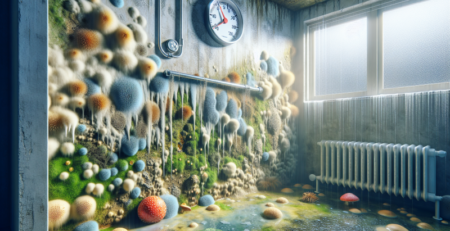Mold Remediation: Safety Tips for Homeowners
Mold remediation is a critical task for homeowners, especially when it comes to ensuring the safety and health of your family. At Kraus Restoration, NJ’s leaders in water, mold, and fire damage restoration, we understand the importance of addressing mold issues promptly and effectively. Our IICRC certified experts are available 24/7 for emergency services, providing rapid response to Central and Northern NJ residents. In this blog, we’ll share essential safety tips for homeowners tackling mold remediation, helping you maintain a healthy living environment. Whether you’re dealing with minor mold spots or extensive mold damage, these guidelines will help you navigate the process safely and efficiently. For professional assistance, don’t hesitate to call us at (973) 886-2021.
Understanding the Health Risks of Mold Exposure
Mold Remediation: Safety Tips for Homeowners
Mold is a common household issue that can pose significant health risks if not addressed promptly and effectively. Understanding the health risks associated with mold exposure is crucial for homeowners to take appropriate measures for mold remediation. This section delves into the potential health hazards of mold exposure and provides insights into why timely intervention is essential.
Mold spores are ubiquitous in the environment and can enter homes through windows, doors, and ventilation systems. Once inside, they can grow on various surfaces, especially in areas with high moisture levels, such as bathrooms, kitchens, and basements. Mold growth can lead to a range of health problems, particularly for individuals with pre-existing health conditions or weakened immune systems.
Health Risks of Mold Exposure
-
Respiratory Issues: One of the most common health problems associated with mold exposure is respiratory issues. Mold spores can irritate the respiratory system, leading to symptoms such as coughing, sneezing, and shortness of breath. According to the Centers for Disease Control and Prevention (CDC), individuals with asthma or chronic respiratory conditions may experience exacerbated symptoms when exposed to mold.
-
Allergic Reactions: Mold exposure can trigger allergic reactions in sensitive individuals. Symptoms may include a runny nose, itchy eyes, skin rashes, and throat irritation. The American College of Allergy, Asthma, and Immunology (ACAAI) notes that mold allergies are quite common and can significantly impact the quality of life.
-
Toxic Mold Syndrome: Certain types of mold, such as Stachybotrys chartarum (black mold), produce mycotoxins that can be particularly harmful. Prolonged exposure to these mycotoxins can lead to toxic mold syndrome, which manifests as severe headaches, fatigue, dizziness, and cognitive impairments. The World Health Organization (WHO) has highlighted the dangers of mycotoxins and their potential impact on human health.
-
Infections: While rare, mold exposure can lead to fungal infections, particularly in individuals with compromised immune systems. These infections can affect the lungs, skin, and other organs, requiring medical intervention.
-
Mental Health Effects: Emerging research suggests that mold exposure may also have psychological effects. Studies have linked mold exposure to symptoms such as anxiety, depression, and difficulty concentrating. This underscores the importance of maintaining a mold-free environment for overall well-being.
Preventive Measures and Remediation
Given the health risks associated with mold exposure, it is crucial for homeowners to take preventive measures and seek professional remediation services when necessary. Here are some tips to help mitigate mold growth and ensure a safe living environment:
- **Control Humidity Levels**: Maintain indoor humidity levels between 30% and 50% to prevent mold growth. Use dehumidifiers and ensure proper ventilation in moisture-prone areas.
- **Fix Leaks Promptly**: Address any water leaks or plumbing issues immediately to prevent moisture accumulation. Regularly inspect areas prone to leaks, such as roofs, windows, and pipes.
- **Clean and Dry**: Clean and dry any areas affected by water damage within 24-48 hours. Use mold-resistant products when renovating or building new structures.
- **Professional Mold Remediation**: If you suspect significant mold growth, consider hiring professional mold remediation services. Experts can assess the extent of the problem and implement effective solutions to eliminate mold and prevent recurrence.
For more information on mold remediation services, visit our mold cleanup page. If you need assistance with water damage, our water cleanup services can help prevent mold growth by addressing the root cause of moisture issues.
Conclusion
Understanding the health risks of mold exposure is essential for homeowners to take proactive steps in maintaining a safe and healthy living environment. By controlling humidity levels, fixing leaks promptly, and seeking professional remediation services when necessary, you can protect your home and your health from the dangers of mold. For more information about our services and how we can assist you, please visit our contact page.
References
- Centers for Disease Control and Prevention (CDC). (n.d.). Mold. Retrieved from [CDC Website](https://www.cdc.gov/mold/)
- American College of Allergy, Asthma, and Immunology (ACAAI). (n.d.). Mold Allergy. Retrieved from [ACAAI Website](https://acaai.org/allergies/types/mold-allergy/)
- World Health Organization (WHO). (n.d.). Mycotoxins. Retrieved from [WHO Website](https://www.who.int/news-room/fact-sheets/detail/mycotoxins)
By staying informed and taking the necessary precautions, you can effectively manage mold issues and safeguard your health and home.
Identifying Mold in Your Home: Common Signs and Symptoms
Mold is a common household issue that can pose significant health risks and damage to your property if not addressed promptly. Identifying mold in your home is the first step toward effective mold remediation. By recognizing the common signs and symptoms of mold growth, you can take timely action to protect your home and your health.
One of the most obvious signs of mold is the presence of visible growth. Mold can appear in various colors, including black, green, white, and even orange. It often has a fuzzy or slimy texture and can be found in damp, dark areas such as basements, bathrooms, and under sinks. If you notice any unusual discoloration or growth on walls, ceilings, or floors, it’s essential to investigate further.
Another common indicator of mold is a musty or earthy odor. Mold produces volatile organic compounds (VOCs) that emit a distinctive smell. This odor is often strongest in areas with poor ventilation and high humidity. If you detect a persistent musty smell in your home, it could be a sign of hidden mold growth.
Water damage is a significant contributor to mold growth. Leaks from pipes, roofs, or windows can create the perfect environment for mold to thrive. If you’ve experienced any form of water damage, it’s crucial to inspect the affected areas for mold. Look for water stains, discoloration, or peeling paint, as these can all be signs of moisture problems that may lead to mold.
Health symptoms can also indicate the presence of mold in your home. Mold spores can cause allergic reactions and respiratory issues, especially in individuals with asthma or weakened immune systems. Common symptoms include sneezing, coughing, nasal congestion, and itchy or watery eyes. If you or your family members experience these symptoms, particularly when spending time in specific areas of your home, mold could be the culprit.
Condensation on windows and walls is another sign of high humidity levels, which can promote mold growth. If you frequently notice condensation, especially during colder months, it’s essential to address the humidity issue to prevent mold from developing. Using dehumidifiers and ensuring proper ventilation can help reduce moisture levels in your home.
Mold can also grow behind wallpaper, under carpets, and inside HVAC systems. If you suspect mold but can’t see it, consider hiring a professional to conduct a thorough inspection. Professionals have the tools and expertise to detect hidden mold and assess the extent of the problem.
If you identify any of these signs or symptoms of mold in your home, it’s crucial to take immediate action. Mold remediation is a complex process that often requires professional intervention. At Kraus Restoration, we offer comprehensive mold cleanup services to ensure your home is safe and mold-free. Our team of experts uses advanced techniques and equipment to effectively remove mold and prevent future growth.
In addition to mold cleanup, we provide a range of other services to address various restoration needs. Whether you’re dealing with water damage, fire damage, or require a complete home restoration, our services are designed to restore your property to its original condition. We understand the importance of a safe and healthy living environment, and we’re committed to delivering high-quality results.
For more information about our services or to schedule an inspection, please contact us today. Our team is ready to assist you with all your restoration needs and ensure your home remains a safe and comfortable place for you and your family.
Essential Personal Protective Equipment (PPE) for Mold Remediation
When tackling mold remediation in your home, ensuring your safety is paramount. Mold can pose serious health risks, including respiratory issues, skin irritation, and allergic reactions. To protect yourself effectively, it is crucial to use the right Personal Protective Equipment (PPE). This guide will outline the essential PPE you need for safe and efficient mold remediation.
Respirators and Masks
One of the most critical pieces of PPE for mold remediation is a respirator or mask. Mold spores are microscopic and can easily become airborne, posing a significant inhalation risk. A standard dust mask is insufficient for this task. Instead, opt for an N95 respirator, which filters out 95% of airborne particles, including mold spores. For more extensive mold infestations, a half-face or full-face respirator with a HEPA filter is recommended. These respirators provide a higher level of protection and are essential for ensuring you do not inhale harmful spores.
Protective Clothing
Wearing appropriate protective clothing is another vital aspect of mold remediation. Mold can easily come into contact with your skin, causing irritation or allergic reactions. Disposable coveralls made from a material like Tyvek are ideal for this purpose. These coveralls are designed to be impermeable to mold spores and other contaminants. Ensure that the coveralls have a hood to protect your head and that they fit snugly around your wrists and ankles to prevent spores from entering.
Gloves
Gloves are essential for protecting your hands from mold exposure. Nitrile gloves are a good choice because they are resistant to chemicals and punctures, providing a barrier against mold spores and cleaning agents. Avoid using latex gloves, as they can cause allergic reactions in some individuals. Ensure that the gloves fit well and extend to cover your wrists, providing comprehensive protection.
Goggles
Eye protection is often overlooked but is crucial during mold remediation. Mold spores can irritate your eyes, leading to redness, itching, and other discomforts. Safety goggles that fit snugly around your eyes and provide a seal are the best option. These goggles will prevent spores from entering and protect your eyes from any cleaning chemicals you might use during the remediation process.
Footwear
Proper footwear is another important consideration. Mold remediation often involves working in damp or wet environments, which can be hazardous. Waterproof boots with a non-slip sole are ideal for this task. These boots will keep your feet dry and provide the necessary traction to prevent slips and falls. Additionally, consider using disposable shoe covers to prevent tracking mold spores to other areas of your home.
Hearing Protection
While not always necessary, hearing protection can be beneficial if you are using loud equipment during the remediation process. Earplugs or earmuffs can help protect your hearing from prolonged exposure to high noise levels, ensuring you remain comfortable and focused on the task at hand.
Conclusion
Using the right PPE is essential for safe and effective mold remediation. Respirators, protective clothing, gloves, goggles, and appropriate footwear all play a crucial role in protecting you from the health risks associated with mold exposure. By investing in high-quality PPE, you can confidently tackle mold remediation in your home, ensuring your safety and well-being.
For more information on mold remediation and other related services, visit our mold cleanup page. If you have any questions or need professional assistance, feel free to contact us. Additionally, you can learn more about our company and the services we offer by visiting our about page.
Step-by-Step Guide to Safe Mold Removal
Mold remediation is a critical task for homeowners to ensure a safe and healthy living environment. Mold can cause various health issues, including respiratory problems, allergies, and skin irritation. Therefore, it’s essential to approach mold removal with caution and follow a systematic process. This step-by-step guide will help you safely and effectively remove mold from your home.
Step 1: Assess the Situation
Before diving into mold removal, it’s crucial to assess the extent of the mold growth. Inspect your home thoroughly, paying close attention to areas prone to moisture, such as bathrooms, kitchens, basements, and attics. Look for visible signs of mold, such as black, green, or white patches on walls, ceilings, and floors. If the mold covers more than 10 square feet, it’s advisable to seek professional help from a mold remediation expert. For more information on professional services, visit our mold cleanup page.
Step 2: Gather Necessary Equipment
Safety is paramount when dealing with mold. Equip yourself with the following protective gear:
- N95 respirator mask
- Gloves (preferably rubber or nitrile)
- Safety goggles
- Long-sleeved shirt and pants
Additionally, you’ll need cleaning supplies such as:
- Detergent or mold cleaner
- Scrub brush
- Disposable rags or paper towels
- Plastic sheeting
- Duct tape
- HEPA vacuum
Step 3: Contain the Mold
To prevent mold spores from spreading to other areas of your home, it’s essential to contain the affected area. Use plastic sheeting to cover doors, windows, and vents. Seal the edges with duct tape to ensure a tight seal. This step is particularly important if you’re dealing with a large mold infestation.
Step 4: Remove Contaminated Materials
Porous materials such as drywall, insulation, and carpeting that are heavily infested with mold may need to be removed and discarded. Carefully cut out and bag these materials in heavy-duty plastic bags. Seal the bags tightly and dispose of them according to local regulations. For guidance on proper disposal, you can contact your local waste management authority or visit our contact page.
Step 5: Clean and Disinfect
Once the contaminated materials are removed, it’s time to clean and disinfect the affected area. Use a detergent or a commercial mold cleaner to scrub the surfaces. Be thorough and ensure that all visible mold is removed. After scrubbing, rinse the area with clean water and dry it completely. To disinfect, you can use a solution of one cup of bleach mixed with one gallon of water. Apply the solution to the cleaned surfaces and let it sit for at least 15 minutes before rinsing and drying.
Step 6: Dry the Area
Mold thrives in damp environments, so it’s crucial to dry the area thoroughly. Use fans, dehumidifiers, and open windows to promote air circulation and speed up the drying process. Ensure that the area remains dry to prevent mold from returning.
Step 7: HEPA Vacuum
After the area is dry, use a HEPA vacuum to remove any remaining mold spores. HEPA vacuums are designed to capture tiny particles, including mold spores, ensuring a thorough clean. Vacuum all surfaces, including floors, walls, and ceilings.
Step 8: Monitor and Prevent Future Mold Growth
After completing the mold removal process, it’s essential to monitor the area for any signs of mold recurrence. Regularly inspect your home for leaks, condensation, and other sources of moisture. Implement preventive measures such as using exhaust fans in bathrooms and kitchens, fixing leaks promptly, and maintaining proper ventilation. For more tips on preventing mold growth, check out our about page.
Conclusion
Mold remediation requires careful planning and execution to ensure the safety and health of your household. By following this step-by-step guide, you can effectively remove mold and prevent future infestations. However, if you encounter a severe mold problem or feel uncertain about handling the task yourself, don’t hesitate to seek professional assistance. For comprehensive mold remediation services, visit our services page.
Preventing Mold Growth: Tips for Maintaining a Mold-Free Home
Mold growth in homes is a common issue that can lead to serious health problems and structural damage if not addressed promptly. Preventing mold growth is crucial for maintaining a healthy living environment. Here are some practical tips to help you keep your home mold-free.
Control Humidity Levels
Mold thrives in moist environments, so controlling humidity is essential. Aim to keep indoor humidity levels below 60%, ideally between 30% and 50%. You can use a hygrometer to monitor humidity levels in your home. If you live in a particularly humid area, consider investing in a dehumidifier to help maintain optimal humidity levels.
Ensure Proper Ventilation
Good ventilation is key to preventing mold growth. Ensure that your home is well-ventilated, especially in areas prone to moisture, such as bathrooms, kitchens, and basements. Use exhaust fans in bathrooms and kitchens to remove excess moisture from the air. Additionally, make sure that your dryer vents to the outside and not into your attic or crawl space.
Fix Leaks Promptly
Water leaks are a common cause of mold growth. Regularly inspect your home for leaks in the roof, walls, and plumbing. If you find any leaks, fix them immediately to prevent water from seeping into walls, floors, and ceilings. Even small leaks can lead to significant mold problems if left unaddressed.
Use Mold-Resistant Products
When renovating or building your home, consider using mold-resistant products. Mold-resistant drywall and paint are excellent options for areas prone to moisture, such as bathrooms and basements. These products are designed to resist mold growth, providing an extra layer of protection for your home.
Clean and Dry Wet Areas Promptly
Mold can start growing within 24-48 hours in damp areas. If you experience water damage from a leak or flood, clean and dry the affected areas as quickly as possible. Use fans and dehumidifiers to speed up the drying process. For extensive water damage, consider hiring professional water cleanup services to ensure thorough drying and mold prevention.
Regularly Inspect and Clean Gutters
Clogged gutters can lead to water overflow, which can seep into your home’s foundation and walls, creating a perfect environment for mold growth. Regularly inspect and clean your gutters to ensure they are free of debris. This simple maintenance task can prevent water damage and mold issues.
Use Air Conditioners and Dehumidifiers
Air conditioners and dehumidifiers can help maintain optimal humidity levels in your home. Ensure that your air conditioning unit is properly maintained and cleaned regularly. A well-functioning air conditioner can help reduce indoor humidity and prevent mold growth.
Monitor Indoor Plants
Indoor plants can contribute to higher humidity levels, creating a conducive environment for mold growth. If you have indoor plants, be mindful of overwatering them. Ensure that the soil is not constantly wet, and consider using a moisture meter to monitor soil moisture levels. Additionally, regularly clean the leaves and pots to prevent mold buildup.
Store Items Properly
Improper storage of items can lead to mold growth, especially in damp areas like basements and attics. Store items in plastic bins with tight-fitting lids instead of cardboard boxes, which can absorb moisture and promote mold growth. Keep stored items off the floor and away from walls to allow for proper air circulation.
Regularly Inspect Your Home
Regular inspections can help you identify potential mold problems before they become serious. Check areas prone to moisture, such as bathrooms, kitchens, basements, and crawl spaces, for signs of mold. Look for discoloration, musty odors, and water stains. If you find any signs of mold, address the issue immediately to prevent further growth.
By following these tips, you can significantly reduce the risk of mold growth in your home. Maintaining a mold-free environment is essential for the health and safety of your family. For more information on mold prevention and remediation, visit our mold cleanup services page. If you need professional assistance, don’t hesitate to contact us for expert help.
When to Call a Professional Mold Remediation Service
Mold growth in your home can pose serious health risks and structural damage if not addressed promptly and effectively. While minor mold issues can sometimes be handled with DIY methods, there are specific situations where calling a professional mold remediation service is not just advisable but necessary. Understanding when to seek professional help can save you time, money, and potential health problems.
One of the primary indicators that you need professional mold remediation is the extent of the mold growth. If the affected area is larger than 10 square feet, it’s generally recommended to call in experts. Large-scale mold infestations often indicate underlying issues such as water damage or high humidity levels that need to be addressed to prevent future growth. Professionals have the equipment and expertise to handle extensive mold problems safely and effectively.
Another critical factor is the type of mold present. While many molds are relatively harmless, some, like black mold (Stachybotrys chartarum), can produce mycotoxins that pose severe health risks. Identifying the type of mold requires specialized knowledge and testing, which professionals can provide. If you suspect the presence of toxic mold, it’s crucial to contact a mold remediation service immediately to ensure the safety of your household.
Health symptoms among household members can also be a sign that professional intervention is needed. Mold exposure can cause a range of health issues, including respiratory problems, allergic reactions, and skin irritation. If anyone in your home is experiencing unexplained health issues, particularly respiratory symptoms like coughing, sneezing, or difficulty breathing, it may be linked to mold exposure. In such cases, a professional assessment and remediation are essential to protect your family’s health.
Visible mold growth is not the only indicator of a problem. Musty odors, especially in areas prone to moisture like basements, bathrooms, or kitchens, can signal hidden mold. Mold can grow behind walls, under floors, and in other hidden areas, making it difficult to detect and remove without professional help. Experts have the tools to locate and eradicate hidden mold, ensuring a thorough cleanup.
Water damage is another red flag that warrants professional mold remediation. Whether it’s from a leaky roof, burst pipe, or flooding, water damage creates an ideal environment for mold growth. If your home has experienced significant water damage, it’s wise to have a professional assess the situation. They can not only remove existing mold but also address the moisture issues to prevent future growth. For more information on how water damage can lead to mold problems, you can visit our water cleanup services page.
Attempting to handle significant mold problems on your own can be risky. Without proper protective gear and containment measures, you can inadvertently spread mold spores throughout your home, exacerbating the problem. Professionals use specialized equipment and techniques to contain and remove mold safely, minimizing the risk of cross-contamination.
In addition to health and safety concerns, professional mold remediation services offer peace of mind. They provide thorough inspections, accurate mold identification, and comprehensive remediation plans tailored to your specific situation. This level of expertise ensures that the mold problem is fully resolved, reducing the likelihood of recurrence.
If you’re unsure whether your mold problem requires professional intervention, it’s always better to err on the side of caution. Consulting with a mold remediation expert can provide clarity and guidance on the best course of action. For more details about our mold remediation services, please visit our mold cleanup services page.
In conclusion, while minor mold issues can sometimes be managed with DIY methods, there are clear situations where professional mold remediation is necessary. Extensive mold growth, toxic mold types, health symptoms, hidden mold, and water damage are all indicators that it’s time to call in the experts. Prioritizing professional intervention not only ensures effective mold removal but also safeguards your health and home. For more information or to schedule a consultation, feel free to contact us.
Post-Remediation: Ensuring Your Home Stays Safe and Mold-Free
After successfully completing mold remediation, it’s crucial to take steps to ensure your home remains safe and mold-free. Mold can be a persistent problem, and without proper precautions, it can quickly return, posing health risks and damaging your property. Here are some essential tips to help you maintain a mold-free environment in your home.
Regular Inspections and Maintenance
One of the most effective ways to prevent mold from returning is to conduct regular inspections and maintenance. Check areas that are prone to moisture, such as basements, bathrooms, and kitchens. Look for signs of water damage, leaks, or condensation. If you find any issues, address them immediately to prevent mold growth. Regular maintenance of your HVAC system is also crucial, as it helps control humidity levels and ensures proper ventilation.
Control Humidity Levels
Mold thrives in humid environments, so it’s essential to keep humidity levels in check. Use dehumidifiers in areas with high humidity, such as basements and bathrooms. Aim to keep indoor humidity levels below 60%, ideally between 30-50%. You can use a hygrometer to monitor humidity levels in your home. Additionally, ensure proper ventilation in areas like the kitchen and bathroom by using exhaust fans to reduce moisture.
Proper Ventilation
Good ventilation is key to preventing mold growth. Ensure that your home is well-ventilated, especially in areas prone to moisture. Open windows and doors when weather permits to allow fresh air to circulate. Use exhaust fans in the kitchen and bathroom to remove excess moisture. If your home has an attic, make sure it is properly ventilated to prevent condensation and mold growth.
Promptly Address Water Leaks
Water leaks are a common cause of mold growth. It’s essential to address any leaks promptly to prevent mold from taking hold. Regularly inspect your plumbing system for leaks and repair them immediately. Pay attention to areas around windows, roofs, and foundations, as these are common spots for water intrusion. If you experience flooding or water damage, it’s crucial to dry the affected areas within 24-48 hours to prevent mold growth.
Use Mold-Resistant Products
When renovating or repairing your home, consider using mold-resistant products. Mold-resistant drywall, paint, and insulation can help prevent mold growth in areas prone to moisture. These products are designed to resist mold and mildew, providing an extra layer of protection for your home.
Clean and Dry Wet Areas Promptly
If you spill water or notice any wet areas in your home, clean and dry them promptly. Mold can start growing within 24-48 hours, so it’s crucial to act quickly. Use fans and dehumidifiers to dry wet areas thoroughly. Pay special attention to areas like carpets, rugs, and upholstery, as these materials can retain moisture and become breeding grounds for mold.
Monitor Indoor Plants
Indoor plants can contribute to higher humidity levels and mold growth if not properly maintained. Ensure that your indoor plants are well-drained and avoid overwatering them. Remove any dead leaves or debris from the soil to prevent mold growth. Consider using a moisture meter to monitor the soil’s moisture levels and adjust watering accordingly.
Educate Your Household
Educating your household members about mold prevention is essential. Make sure everyone understands the importance of controlling humidity levels, promptly addressing water leaks, and maintaining proper ventilation. Encourage good habits, such as wiping down wet surfaces and using exhaust fans in the kitchen and bathroom.
Professional Help
If you suspect mold growth or experience water damage, don’t hesitate to seek professional help. Professional mold remediation services can effectively address mold issues and prevent them from recurring. They have the expertise and equipment to thoroughly clean and disinfect affected areas, ensuring your home remains safe and mold-free. For more information on professional mold remediation, visit our mold cleanup services page.
Maintaining a mold-free home requires vigilance and proactive measures. By following these tips, you can ensure that your home remains a safe and healthy environment for you and your family. For more information on maintaining a mold-free home, feel free to contact us or explore our services page.
In conclusion, mold remediation is a critical process for maintaining a healthy and safe living environment. By understanding the potential health risks associated with mold exposure and following the safety tips outlined in this blog, homeowners can effectively address mold issues in their homes. Remember to always wear appropriate protective gear, use proper cleaning techniques, and consider consulting with professionals when necessary. Taking proactive steps to prevent mold growth, such as controlling humidity levels and promptly addressing water leaks, can also help safeguard your home and your family’s well-being. Stay informed, stay vigilant, and ensure that your home remains a safe haven free from the dangers of mold.
